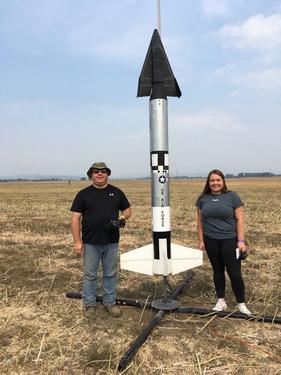
Radio Controlled Rocket Glider Kits
I've also experimented using depron foam sheets to construct large lightweight rockets using the foam as the centering rings, stringers, fins and skin allowing me to fly using smaller cheaper motors. Typically these will be 6-10" in diameter and 70-80" tall yet weigh only 5 pounds compared to 20# for a similar highpower rocket built using cardboard tubing and plywood. Click on the buttons below to view youtube playlists of several flights of my rocketgliders on the left, and my foam rockets on the right. The pinnacle of this venture has been my 8" diameter Titan II with RC Dynasoar Glider on top that is 9' tall, weighs only 80 ounces ready to fly with H-97 rocket motor. The Playlist button has several flights, construction photos and onboard video.
About Us: I've been flying RC for more than 30 years, and flying rockets for more than 40. I'm NAR level 2 certified. About 10 years ago I started designing my own depron profile parkjets and publishing plans on rcgroups. Since then, I've designed, built and flown over 100 different parkjet and Rocket boosted glider designs. I've had articles and pictures published in several rocketry and model aviation magazines.
In march of 2015 I started making kits of a few of my simpler designs at the request of several people who wanted to try RC rocket gliders but were not familiar with working with Depron and working from plans and did not have access to all of the little bits and pieces. It's been a learning process, ordering in bulk, finding alternate sources, making templates, redesigning the models to be able to fit into a box that did not cost a fortune to ship, creating online instructions/photo guides etc. These kits are cut to order personally by me using 6mm depron foam, and include high quality carbon fiber rods, 3m blenderm and velcro tape and dubro/great planes hardware. I've designed and published plans and kitted over 30 RC rocket gliders since then. Dynasoar rocketry has had several firsts. We were the first to kit truly flyable RC rocket gliders of the X-15, X-24, HL-10 and X-20 lifting bodies, AQM37 Jayhawk, Bomarc Missile, F-106 Delta Dart, F-105 Thunderchief, Mig 21, V-1 Buzzbomb and Orbital Pegasus. We pioneered the application of profile parkjet design to rocket boosted gliders for light weight and gentle flight characteristics.
My design philosopy is simple. Make things that fly well, are simple to build, and that look like a real airplane or rocketplane. These designs are simple and light, will penetrate the wind quite well, but land like a feather. Since there is no airfoil they can boost straight up with neutral controls without any tendency to pitch or climb. This means they can launch from a normal rail or rod and require minimal control on boost to adjust for any wind. Once the motor burns out, they are slightly nose heavy and require a small amount of up trim for a stable glide. The motor is not ejected and the model recovers ready to fly immediately.
For the foam structured rockets, here is what I've learned:
I use a stuffer tube that goes up to a wider parachute bay, as far up as possible, leave just enough room for the chute and wadding/blanket which puts the weight up forward. I try to put any needed nose weight around the parachute bay and under any skin and not in the very small nose portion that ejects so you minimize a heavy nose swinging around to hit the body tube.
The foams I use don't really conform that well below 6" diameter even the 2mm foam skin. Below those diameters I'd consider a cardboard wrap for the skin. However lightweight 4" tubing is pretty light, so you may not come out lighter than a bt-101 tube if you are doing it at that scale, but if you are just doing it for learning/fun or to do something different go for it. I think the sweet spot for the foam structures are 6"-10" diameters which will lead to weights from 4-6 pounds and fly on 29mm motors up to 1000'. I did do a 5.5" pershing 1A that is really lightweight that has a 24mm tube and a bt-70 parachute bay that weighs 20 ounces ready to fly. ON that I used 1mm depron but that has a tendency to kink when wrapping that small of a diameter. I would say if you do a 4" version with the stringers/skin it will probably be stronger than just a bt-101 tube based model...Mine have survived up to 13g launches with no ill effects. I'd probably not try to skin that small of a rocket with the dollar tree foam, I think even with heat to conform it you'd wind up with a really thick skin, but maybe it will work.
Here's my experience with the foam fins on bigger rockets: They will eventually get some damage, just accept it Even with carbon reinforcement they will hit something hard when swinging or landing and you just have to patch or CA them. Nothing so far in two years of flying these has been destroyed but they get scars. The two that have survived with no damage so far are the Titan II and Atlas Missile which have clear fins with foam bodies/skin. The fins are locked into slotted/grooved ply centering rings so that any bending load from the fins on landing doesn't transfer to the skin and cause any crushing. Even with parachute tangles the repairs have been easy since the models tend to fall horizontally and are so light for their size they land relatively lightly.
I've done these where the stringers go all the way to the stuffer tube and some where they went about halfway, they all seem to survive the flights. I use notches in the centering rings and stringers to lock things together and it allows me to make sure things are straight before gluing the structure together. I do put a double wide stringer where the seam will go for the skin so that even if things aren't perfectly straight you are able to have good overlap for the seam on a stringer line. I skin the rocket before adding fins, or the forward tapered areas so that I can leave some overlap on the ends and trim the skin later otherwise you have to cut it perfectly and get it aligned right the first time when adding it. I usually do the forward tapered areas separately then slide them down onto the stuffer tube, then add the parachute bay last..it's much easier to skin separate pieces...if the model design allows. I'm talking about the titan and atlas for example that have tapered forward sections..
I use a ply plate at the bottom for thrust and to mount my rear rail button to. On the top I do the same. I also tie my recovery system to the top ply plate to take the recovery stress. I reinforce the top of the parachute bay lip on the outside to prevent zippering.
Using some monokote trim or vinyl over the skin helps add some road rash protection to the foam skin if you are using that.
Main thing I do is to make a little spreadsheet to calculate overall weight and use openrocket and put in all of the weights up front to make sure I know how much nose weight I will need and figure out where it will go and how much motor I will need so I plan for the right nose weight. Otherwise you wind up building something that is too heavy and needs a bigger motor and then needs more nose weight, larger chute and you don't have room for it. With the weight not in the nose your balast needs to be correct ahead of time, or you have to add it to the nose which I try to avoid. If you do need to you can put it in the base of the coupler that I talk about below.
For the nose cone, I use a coupler as the shoulder that goes into the parachute bay and has a ply plate at the top then attach the recovery system to that and then mount the foam nose on top of that plate, maybe with a carbon rod up the middle to lock it together. I like the open coupler as the shoulder because it doesn't rob any of the room in the parachute bay and can slide over the chute if needed as you put the nose in place.
I make an altimeter pod that can be accessed via a door near the top of the model and route wires up into the parachute bay via the stuffer tube to attach the deployment charge, I can swap the pod from model to model. For a 4" setup I assume you probably won't do that.
Each design is slightly different, how many fins, the shapes, where they will mount, all take some though about landing and flight loads to figure out how and where to reinforce them. I typicall skin the body then cut out for the fins afterward, I make marks in my base plate so that I know where the fins will need to be inserted...Sometimes the skin will pucker up after you cut the slots, on those I may put a small foam flange on the fin which helps push the skin back down level after you've inserted the fin, I did that on my falcon missile...
Hope that helps.
In any case they are a lot of fun, people are always interested in them. I can build in any diameter I want and in larger sizes it is cheaper than buying body tubes.
If you read this thread, it shows a bunch of pictures of the internal construction of an example:
http://www.rocketryforum.com/showthread.php?129953-Full-Scale-Aim-4-Falcon-Missile

